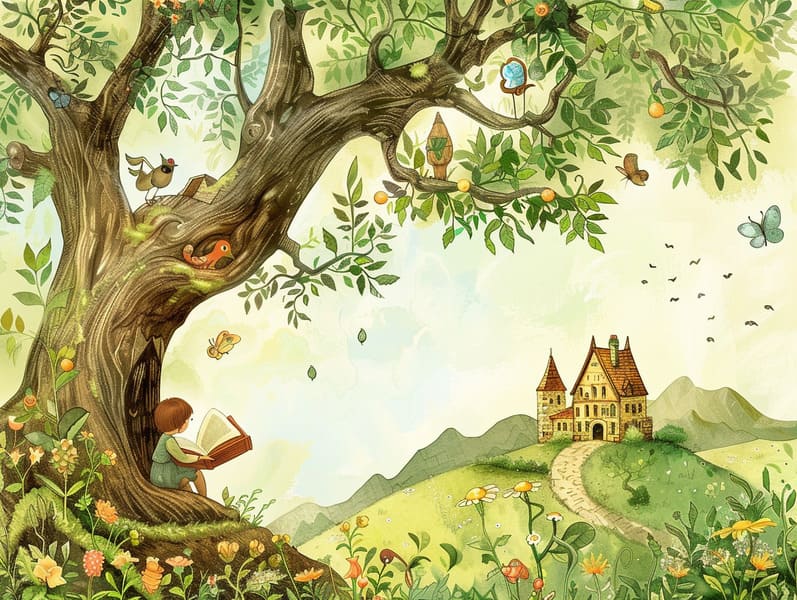
Legendary fairy tales have old origins. These tales have been told from one generation to the next far before they were ever recorded. They developed from a variety of societies, including Asian traditions. They were initially shared among older generations, often carrying themes and messages mirroring the societal norms and beliefs of the time.
The Brothers Grimm, Jacob and Wilhelm, were among the first to gather many of these beloved stories. Their published works, "Grimm's Fairy Tales," included stories like "The True Bride," "Little Brother and Little Sister," and "Snow White," which have since become classics in the world of children's fairy tales. Similarly, Hans Andersen's fantastical narratives, such as "The Story of the Little Mermaid," and "The Little Duckling," have captured hearts worldwide, establishing their place in the pantheon of classic fairy tales.
Even though they are old, traditional fairy tales remain as important as ever, especially as children's bedtime stories. These magical stories are now available in various formats, including gorgeously illustrated books, magical animations, and online fairy tales.
Their lasting presence can be ascribed to several whimsical characteristics:
Crucial Morals: Ancient fairy tales often provide important moral lessons. Stories like "The Story of the Boy Who Cried Wolf" teach the virtue of being truthful, while "The Race of the Tortoise and the Hare" stress the merits of perseverance and humbleness. These tales offer young readers clear distinctions between truth and falsehood, forming their moral compass in a kind yet lasting way.
Empathy and Awareness: Classic fairy tales frequently feature heroes facing difficulties and adversities, fostering young listeners to comprehend with their struggles and back their triumphs. For instance, "Beauty and the Beast" conveys the virtue of looking beyond appearances to realize the inner core of a character, strengthening perception and awareness.
Cultural Appreciation: Many old fairy tales are deeply embedded in the cultural contexts from which they came. Engaging with these fairy tales can provide fascinating glimpses into different cultures, cultivating a sense of cultural insight and appreciation.
Inventiveness and Imagination: The enchanted elements in ancient fairy tales—mythical creatures—generate children’s innovations. These narratives guide readers to fantasy realms, revitalizing creative thinking and a sense of delight that endures a lifetime.
Old fairy tales are not only enchanting but also illuminating. They act as whimsical tools in cultivating various intellectual and emotional capacities in kids. When fairy tales are recited, they cultivate linguistic abilities by showing new language items and complex sentence structures. This practice also enhances auditory perception and focus, as children concentrate deeply, looking forward to see what happens next.
Furthermore, talking about the themes and characters of classic fairy tales can foster evaluative skills and logical thinking. Kids are instructed to detect patterns, anticipate outcomes, and figure out cause and effect. These explorations also ease the young communicate their thoughts and feelings, adding to their emotional intelligence.
In today’s cyber age, the availability of internet fairy tales has made these fairy tales more acquirable than ever. Internet resources and online apps feature vast collections of timeless fairy tales that can be read or played anytime, anywhere. Fairy tales told out loud are particularly well-liked, sharing an fascinating method for kids to immerse in these fascinating tales. Read-aloud stories and spoken videos guide characters and settings to life, often joined by magical sound effects and songs that heighten the tale-telling adventure.
The lasting appeal of traditional fairy tales lies in their ability to evolve to modern society while preserving their main lessons. Contemporary modernizations of these stories often show more multicultural figures and modern settings, making them relevant to today’s audience. However, the essential messages of boldness, humanity, and justice remain unchanged, continuing to move kids of all ages.
Fairy tales also offer a sense of security and predictability. They furnish a coherent narrative with a definite beginning, middle, and end, often wrapping up with the conclusion of conflicts and the triumph of justice over injustice. This dependability can be calming for kids, furnishing a sense of unwaveringness in an shifting world.
Traditional fairy tales continue to fascinate and teach new generations, maintaining their splendor and meaningfulness in modern society. As children's bedtime stories, they bequeath a perfect blend of charm and enlightenment, enriching moral values, empathy, and creativity. The prevalence of digital fairy tales and the likability of fairy tales spoken assure that these old fairy tales remain reachable to new generations.
By maintaining and relating these stories, we continue to value the rich tapestry of narrative artistry and cultural heritage. Whether you are exploring a colorful picture book, perusing a internet collection, or listening through an spoken story, the elegance of popular fairy tales is always here within reach. These fairy tales emphasize of the lasting nature of tales and its ability to unify us across centuries and lands.
If you are exploring a beautifully illustrated book, delving into a online collection, or hearing an audiobook, the mystique of timeless fairy tales is always within reach.
These fairy tales highlight of the consistent effect of narratives and its ability to unite us across generations and cultures, forging a link that delights and instructs alike.
Comments on “The Rise of Bedtime Fairy Tales with the Unfading Allure.”